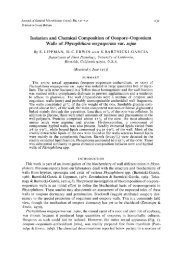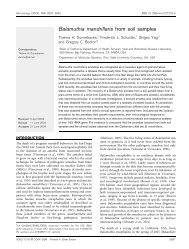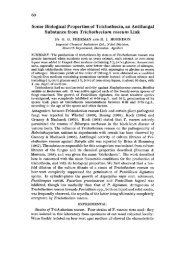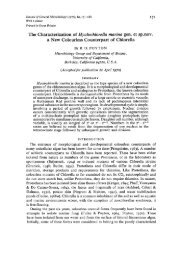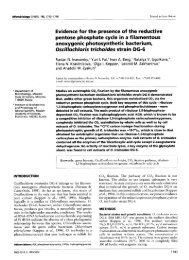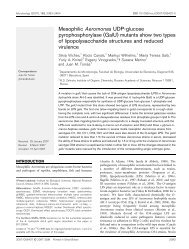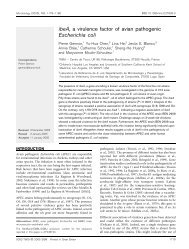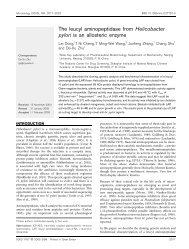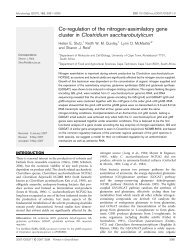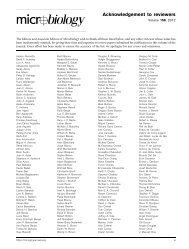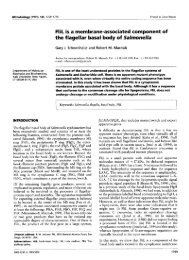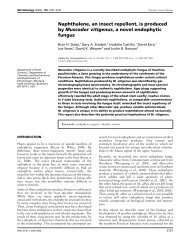Gloeocapsa (Gloeothece) sp. CCAP 143013 - Microbiology
Gloeocapsa (Gloeothece) sp. CCAP 143013 - Microbiology
Gloeocapsa (Gloeothece) sp. CCAP 143013 - Microbiology
Create successful ePaper yourself
Turn your PDF publications into a flip-book with our unique Google optimized e-Paper software.
Journal of General <strong>Microbiology</strong> (1982), 128,885-893. Printed in Great Britain<br />
The Effects of Structural Analogues of Amino Acids on Ammonium<br />
Assimilation and Acetylene Reduction (Nitrogen Fixation) in<br />
<strong>Gloeocapsa</strong> (<strong>Gloeothece</strong>) <strong>sp</strong>. <strong>CCAP</strong> <strong>143013</strong><br />
By JEANETTE H. THOMAS, PHILIP M. MULLINEAUX,<br />
ANDREW D. CRONSHAW, ALAN E. CHAPLIN AND<br />
JOHN R. GALLON*<br />
Department of Biochemistry, University College of Swansea, Singleton Park,<br />
Swansea SA2 8PP, U.K.<br />
(Received 9 July 1981; revised 10 September 1981)<br />
In <strong>Gloeocapsa</strong>, NH; formed by N, fixation was assimilated by the glutamine synthetaseglutamate<br />
synthase pathway. The inhibition of acetylene reduction following addition of<br />
NH; to N,-fixing cultures was not caused by NH; itself but was, most probably, related to<br />
increased intracellular levels of glutamine.<br />
Analogues of several amino acids inhibited acetylene reduction. Apart from glutamine<br />
analogues, which interfered with NHt assimilation, these analogues probably acted by<br />
inhibiting nitrogenase synthesis. Certain analogues of tryptophan and phenylalanine, which<br />
have been reported to overcome NH; inhibition of cell differentiation and, possibly, nitrogenase<br />
synthesis in heterocystous cyanobacteria growing on combined nitrogen, did not<br />
prevent NH; from inhibiting acetylene reduction in cultures of <strong>Gloeocapsa</strong>. In contrast,<br />
L-methionine-DL-sulphoximine, which similarly counteracts the effect of NH; on heterocyst<br />
differentiation, also prevented NH; from inhibiting acetylene reduction in <strong>Gloeocapsa</strong>.<br />
INTRODUCTION<br />
In N,-fixing cyanobacteria, as in many other organisms, assimilation of NH: proceeds by<br />
the glutamine synthetase (EC 6.3.1 .2)-glutamate synthase (EC 1 ,4.7.1: the cyano-<br />
bacterial enzyme is ferredoxin-dependent) pathway (see Miflin & Lea, 1976). Evidence for<br />
the operation of this pathway has been provided by enzymological studies (Dharmawardene<br />
et al., 1973; Lea & Miflin, 1975), radioisotopic data (Meeks et al., 1977, 1978) and also<br />
by the use of inhibitors of glutamine and glutamate metabolism, such as L-methionine-<br />
DL-sulphoximine (Stewart & Rowell, 1975) and azaserine (Meeks et al., 1977). These<br />
inhibitors have also proved useful in studying the mechanism whereby exogenously supplied<br />
NH,+ inhibits nitrogenase (EC 1 . 18.2. l), the N,-fixing enzyme.<br />
Other inhibitors of amino acid metabolism have also been used to investigate N, fixation<br />
(acetylene reduction) by cyanobacteria. For example, when added to cultures of hetero-<br />
cystous cyanobacteria growing in medium containing combined nitrogen, certain analogues<br />
of tryptophan (Bottomley et al., 1980) and phenylalanine (Rogerson, 1979) allowed the<br />
differentiation of vegetative cells into heterocysts. Heterocysts are the site of aerobic N,<br />
fixation in these organisms, but there have been conflicting reports about whether, in the<br />
presence of these analogues, nitrogenase activity appears along with cell differentiation<br />
(Bothe & Eisbrenner, 1977; Bottomley et al., 1980; Rogerson, 1979). Finally, canavanine,<br />
a structural analogue of arginine, has been reported to inhibit nitrogenase synthesis in<br />
cultures of Anabaenaflos-aquae (Bone, 1972).<br />
0022-1287/82/0001-0046 $02.00 0 1982 SGM<br />
885
886<br />
J. H. THOMAS AND OTHERS<br />
The unicellular cy anobacterium <strong>Gloeocapsa</strong> (<strong>Gloeothece</strong>) fixes N, aerobically even though<br />
it does not possess heterocysts. Consequently, <strong>Gloeocapsa</strong> is a useful organism in which to<br />
study the effects of analogues of amino acids on N, fixation, because these effects cannot be<br />
complicated by cell differentiation. Although in <strong>Gloeocapsa</strong> NH; is probably assimilated by<br />
the glutamine synthetase-glutamate synthase pathway (Gallon et al., 1978; Meeks et al.,<br />
1978), there has been no systematic attempt to examine the enzymes of NHZ assimilation<br />
in this organism. In this paper, therefore, we report an investigation into the pathways of<br />
NHt assimilation by N,-fixing cultures of <strong>Gloeocapsa</strong> and also report the effect on acetylene<br />
reduction of inhibitors of NHZ assimilation and structural analogues of various amino acids.<br />
METHODS<br />
MateriaZs. 2-Amino-4-oxo-5-chloropentanoic acid (AOCP) was synthesized from N-carboxybenzoxy-La<strong>sp</strong>artyl-a-benzyl<br />
ester (Cambrian Chemicals, Croydon) as described by Khedouri et al. (1966). L-Methionine-<br />
DL-sulphoximine (MSX) and azaserine were purchased from Calbiochem, and all other chemicals from Sigma.<br />
Growth of cultures. Gloeocupsa <strong>sp</strong>. <strong>CCAP</strong> 1430/3 (Culture Centre of Algae and Protozoa, Cambridge) was<br />
grown in 15 1 sterile medium, either free of combined nitrogen (Gallon et al., 1978) or containing 2 mM-<br />
NH,Cl (Mullineaux et ul., 1980).<br />
Preparation of extracts of Gloeocupsa. For the assay of all enzymes except nitrogenase, broken-cell<br />
su<strong>sp</strong>ensions and cell-free extracts of <strong>Gloeocapsa</strong> were prepared as described by Toziim & Gallon (1979).<br />
Enzyme assays. N, fixation by cultures (lo5 to lo6 cells ml-I) was measured by the acetylene reduction<br />
technique (Tozum et al., 1977) after 4 h aerobic incubation under illlumination at 2500 lx.<br />
Glutamine synthetase (EC 6.3 . 1 .2) was routinely measured in cell-free extracts by the yglutamyl transferase<br />
assay of Woolfolk et al. (1966). The Km of the enzyme for NHt was measured using the biosynthetic assay<br />
of Shapiro & Stadtman (1970). Gluturnate synthase (EC 1 .4.7.1) was assayed anaerobically as described<br />
by Lea & Main (1975) using broken-cell preparations prepared under N,. The ferredoxin used in this assay was<br />
isolated from Gloeocupsa (Gallon et al., 1973). Glutaminase (EC 3.5.1.2) activity was measured as described<br />
by Bergmeyer (1 974) except that the buffer used was 50 m~-N-2-hydroxyethylpiperazine-N'-2-ethanesulphonic<br />
acid (HEPES)/NaOH, pH 7.5. Alanine dehydrogenase (EC 1.4.1. l), glutamate dehydrogenase<br />
(EC 1.4.1.2) and glycine dehydrogenase (EC 1.4.1.10) were assayed by following the NHt-dependent<br />
oxidation of NAD(P)H at 340nm in the presence of the appropriate 2-0x0 acid (Haystead et al., 1973).<br />
Carbamoyl-pho<strong>sp</strong>hate synthetase (glutamine-hydrolysing) (EC 6.3.5.5) and carbamoyl-pho<strong>sp</strong>hate synthetase<br />
(NHt) (EC 6.3.4.16) were assayed by measuring the conversion of Nai4C0, t2.5 pCi (92 kBq); 0.33 pnoll to<br />
[l4C1hydroxyurea following 10 min incubation with a broken-cell su<strong>sp</strong>ension (0.5 ml) of <strong>Gloeocapsa</strong> (Levine &<br />
Kretchmer, 1971).<br />
Other assays. Extracellular NHt was measured by the method of Chaney & Marbach (1962) using 1 ml<br />
medium removed from 5 ml samples of <strong>Gloeocapsa</strong> (concentrated 10-fold), previously incubated at 25 OC for<br />
24 h under illumination at 2500 lx. Incorporation of radioactivity from Nai4C0, into glutamate and glutamine<br />
was measured, after 4 h incubation with or without analogues, as described by Gallon et al. (1978). Protein was<br />
measured as described by Bailey (1962). Cell numbers were measured in a haemocytometer (Toziim & Gallon,<br />
1 9 79).<br />
RESULTS AND DISCUSSION<br />
The enzymes of NH; assimilation<br />
Several NHZ-assimilating enzymes were detected in extracts of <strong>Gloeocapsa</strong> <strong>sp</strong>. 1430/3<br />
(Table l), glutamine synthetase being the most active under N,-fixing conditions. With<br />
NH; as substrate, the K, of this enzyme was considerably lower than that of either<br />
alanine dehydrogenase or glutamate dehydrogenase, the next most active enzymes. In N,-<br />
fixing cultures, therefore, NHt is probably assimilated primarily by glutamine synthetase.<br />
However, in extracts from cultures growing on NHt, glutamate dehydrogenase (NADP)<br />
was the most active NHt-assimilating enzyme and may be involved in NHt assimilation<br />
under these conditions.<br />
Under N,-fixing conditions, the amino acid dehydrogenases could be involved in NHt-<br />
assimilation, but their low affinity for NHt suggests that they would be effective only when<br />
intracellular NHt accumulated to a very high level. Both alanine dehydrogenase and
Amino acid analogues and <strong>Gloeocapsa</strong><br />
Table 1. Activities of enzymes associated with NH; assimilation in <strong>Gloeocapsa</strong><br />
Enzyme<br />
Glutamine synthetase<br />
Glutamate synthase<br />
Glutamate<br />
dehydrogenase (NADP)<br />
Alanine<br />
dehydrogenase (NAD)<br />
G1 y cine<br />
dehydrogenase (NAD)<br />
Carbamoyl-pho<strong>sp</strong>hate<br />
synthetase (glutamine)<br />
Carbamoyl-pho<strong>sp</strong>hate<br />
synthetase (NHt)<br />
r<br />
Specific activity<br />
[pkat (mg protein)-']<br />
~<br />
N,-grown NH: grown K, for NH:<br />
cultures cultures (MI<br />
976 34 1 4.0 x 10-4<br />
600 ND ND<br />
167 797 4-2 x lo-'<br />
23 1 29 1 6-9 x lo-'<br />
3.<br />
5.67 ND ND<br />
1-35 ND ND<br />
0.13<br />
ND, Not determined.<br />
ND ND<br />
glycine dehydrogenase required NAD as cofactor, and may therefore be a single enzyme.<br />
On the other hand, glutamate dehydrogenase required NADP and therefore appears to be<br />
distinct from the other dehydrogenases. A similar situation exists in extracts of Anabaena<br />
cylindrica which were found to contain NAD-dependent alanine and a<strong>sp</strong>artate dehydro-<br />
genases, but NADP-dependent glutamate dehydrogenase (Haystead et al., 1973). No<br />
a<strong>sp</strong>artate dehydrogenase was found in extracts of <strong>Gloeocapsa</strong>, though high rates of oxidation<br />
of NADH occurred in the presence of oxaloacetate, whether or not NHt was also added;<br />
this activity was probably the result of NAD-dependent malate dehydrogenase<br />
(EC 1.1.1.37).<br />
Extracts of N,-fixing cultures of <strong>Gloeocapsa</strong> also contained glutamate synthase which, as<br />
in other cyanobacteria (Lea & Miflin, 1975), required reduced ferredoxin as cofactor. The<br />
<strong>sp</strong>ecific activity of this enzyme was slightly lower than that of glutamine synthetase, but this<br />
might be a result of the difficulty of maintaining anaerobic conditions during isolation and<br />
assay of glutamate synthase. The observed rates of glutamine synthetase and glutamate<br />
synthase activity would be sufficient to assimilate NHt produced by nitrogenase, which had a<br />
maximum <strong>sp</strong>ecific activity (acetylene reduction) of about 300 pkat (mg protein)-'.<br />
Addition of NH; to N,-fixing cyanobacteria leads to a rapid decrease in nitrogenase<br />
activity, and it has been suggested that glutamine synthetase or a product of NHt assimi-<br />
lation is involved in this effect (see Stewart, 1980). One such product is carbamoyl pho<strong>sp</strong>hate,<br />
which inhibits nitrogenase when added to cultures of cyanobacteria (Lawrie, 1979) including<br />
<strong>Gloeocapsa</strong> (Gallon et al., 1978; Gallon, 1980). Carbamoyl-pho<strong>sp</strong>hate synthetase activity<br />
was found in extracts of <strong>Gloeocapsa</strong> (Table 1). Activity was greater with glutamine, as<br />
nitrogen donor than with NH;, in contrast to the findings of Lawrie (1979) with A. cylindrica.<br />
Since the glutmine-dependent carbamoyl pho<strong>sp</strong>hate synthetase of Escherichia coli was<br />
active with both NHt and glutamine (Trotta et al., 1973), both carbamoyl-pho<strong>sp</strong>hate<br />
synthetase activities in <strong>Gloeocapsa</strong> may be due to a single, glutamine-dependent, enzyme. No<br />
glutaminase was detected in extracts of <strong>Gloeocapsa</strong>, so the activity of glutmine-dependent<br />
carbamoyl pho<strong>sp</strong>hate synthetase was not the result of the combined activities of glutaminase<br />
and carbamoyl synthetase (NHt).<br />
Inhibitors of glutamine synthetase<br />
L-Methionine-DL-sulphoximine (MSX) is reported to inhibit glutamine synthetase<br />
irreversibly, probably by attachment to both the glutamate and the NH; binding sites<br />
(Meister, 1968). 5-Hydroxylysine is a reversible inhibitor of glutamine synthetase and<br />
887
888 J. H. THOMAS AND OTHERS<br />
Table 2. Egect of inhibitors of NHT assimilation on acetylene reduction by <strong>Gloeocapsa</strong><br />
Cells were collected from batch cultures during the late exponential phase of growth (6 to 10d after<br />
inoculation). They were then incubated aerobically in the light for 4 h with 5 mM-HEPES/NaOH buffer,<br />
pH 7.5, and the compounds indicated. Acetylene was added to 2% (v/v) and the rate of acetylene<br />
reduction was measured over the following 60 min. The rates of acetylene reduction are typical; the<br />
percentages are the means of at least 12 observations.<br />
None<br />
2 mM-MSX<br />
2 m~-5-Hydroxylysine<br />
2 mM-AOCP<br />
0.2 mM-AOCP<br />
20 w-AOCP<br />
2 mM-Azaserine<br />
0.2 mM-Azaserine<br />
Acetylene reduction Percentage of<br />
[pmol min-' uninhibited<br />
Addition (lo6 cells)-'] activity<br />
24.3 100<br />
16.5 68<br />
14.9 61<br />
7.3 30<br />
11.4 47<br />
16.5 68<br />
2.8 12<br />
17.0 70<br />
2 mM-Albizziine 2.2 9<br />
2 mM-S-Carbamoyl cysteine 2.2 9<br />
2 mM-Gilutamic acid- yhydrazide 73.3 30 1<br />
2 mM-Glutamhe<br />
2 mM-Glutamate<br />
2 mM-Methionine<br />
14.9 61<br />
20.2 83<br />
19.7 81<br />
shows kinetics of competitive inhibition (Rabinowitz et al., 1957; Stewart, 1980). Both<br />
2 mM-MSX and 2 m~-5-hydroxylysine inhibited glutamine synthetase by 95 % in extracts of<br />
<strong>Gloeocapsa</strong>. N,-fixing cultures excreted NHt when incubated with 2 mM-MSX [ 12.5 pmol<br />
min-l ( lo6 cells)-'] or 2 m~-5-hydroxylysine [4- 16 pmol min-' ( lo6 cells)-']. This suggests<br />
that glutamine synthetase catalyses the initial step of NHt assimilation in <strong>Gloeocapsa</strong><br />
and is further evidence for the operation of the glutamine synthetase-glutamate synthase<br />
pathway under N,-fixing conditions.<br />
Acetylene reduction was slightly inhibited by 2 mM-MSX or 2 m~-5-hydroxylysine<br />
(Table 2). It is not clear whether simultaneous addition of 2 mM-glutamine prevented these<br />
inhibitions, because glutamine itself inhibited acetylene reduction (Table 2). Inhibition of<br />
acetylene reduction by 2 mM-MSX was prevented by addition of 2 mM-methionhe.<br />
Incubation for 4 h with 2 mM-NH,Cl markedly inhibited acetylene reduction, but addition of<br />
2 mM-MSX or 2 m~-5-hydroxylysine greatly decreased the effect of NHt (Table 3). Indeed,<br />
if allowance is made for the inhibitory effects of MSX and 5-hydroxylysine themselves (Table<br />
2), these compounds almost completely prevented NHt from inhibiting acetylene reduction.<br />
Glutamine synthetase in cultures of other cyanobacteria was inhibited by MSX at concentrations<br />
much lower than 2 mM (Stewart & Rowell, 1975; Meeks et al., 1978). However, in<br />
Gloeocapsu, 20 PM- or 0.2 mM-MSX failed to prevent NHt from inhibiting acetylene<br />
reduction, probably because MSX may be poorly assimilated by Gloeocupsa. This view is<br />
supported by the observation that simultaneous addition of either 2 mM-glutamine or 2 mMmethionine<br />
markedly lowered the effect of MSX in preventing inhibition by NHt (Table 3),<br />
probably by interfering with the uptake of MSX (Meins & Abrams, 1972).<br />
That inhibitors of glutamine synthetase prevented NHt from inhibiting acetylene reduction<br />
in Gloeocapsu suggests that NHt itself was not the inhibitor and that a product of NHt<br />
assimilation may have been involved. Addition of glutamine, itself an early product of NHt<br />
assimilation, only slightly inhibited acetylene reduction (Table 2) but glutamine may not<br />
be readily assimilated by <strong>Gloeocapsa</strong>. Alternatively, carbamoyl pho<strong>sp</strong>hate, formed from<br />
glutamine, could be the inhibitor (Gallon, 1980).
Amino acid analogues and <strong>Gloeocapsa</strong><br />
Table 3. Amino acid analogues and the eflect of NH,+ on acetylene reduction by <strong>Gloeocapsa</strong><br />
The assays were done as described for Table 2. The rates of acetylene reduction are typical; the<br />
percentages are the means of at least 12 observations. The figures in parentheses show these per-<br />
centages after correction for the effect of the analogue itself (see Table 2).<br />
Addition*<br />
None<br />
2 mM-NH,CI<br />
2 mM-NH,Cl + 2 mM-MSX<br />
2 mM-NH,CI + 2 mM-MSX +<br />
2 mwglutamine<br />
2 mM-NH,Cl+ 2 mM-MSX +<br />
2 mM-methionine<br />
2 ~M-NH,CI + 2 mM 5-hydroxylysine<br />
2 rnM-NH,Cl + 2 mM-AOCP<br />
2 mM-NH,CI+ 0.2 mM-AOCP<br />
2 mM-NH,CI + 20 C(M-AOCP<br />
2 rn~-NH,cl + 0-2 mM-azaserhe<br />
Acetylene reduction Percentage of<br />
[pmol min-' uninhibited<br />
(lo6 cells)-'] activity<br />
17.6 100<br />
3.9 22<br />
9.7 55 (81)<br />
5-1 29<br />
5.8 33<br />
9.7 55 (90)<br />
2.6 15 (50)<br />
4-4 25 (53)<br />
5.3 30 (44)<br />
0-9 5 (7)<br />
*The following additions were without effect, at 2 mM, on the inhibition of acetylene reduction by NH::<br />
7-azatryptophan, 4-fluorotryptophan, 5-methyltryptophan, canavanine, azetidine-2-carboxylate, 4-flUOrO-<br />
phenylalanine and /3-2-thienylalanine.<br />
Analogues of glutamine<br />
Azaserine and albizziine have both been reported to inhibit glutamate synthase, the second<br />
enzyme in the pathway of NHf assimilation (Lea & Norris, 1976; Miflin & Lea, 1976).<br />
Azaserine (2 mM) completely inhibited glutamate synthase in extracts and, when added to<br />
cultures incubated with Na:4C0,, caused an accumulation of ''Clglutamine [from 16 to<br />
207 Bq (lo6 cells)-'] at the expense of [l4CIglutamate [which decreased from 176 to 7 Bq<br />
( lo6 cells)-']. This is consistent with the operation of the glutamine synthetase-glutamate<br />
synthase pathway in <strong>Gloeocapsa</strong>.<br />
Although azaserine, albizziine and S-carbamoyl cysteine are analogues of glutamine,<br />
they neither significantly inhibited glutamine synthetase in vitro, nor caused excretion of<br />
NHf when added to a N,-fixing culture. At 2m~, azaserine, albizziine or S-carbamoyl<br />
cysteine severely inhibited acetylene reduction by cultures of <strong>Gloeocapsa</strong> (Table 2). Although<br />
002mM-azaserine was less inhibitory (Table 2), it exacerbated the effect of added NHf<br />
(Table 3). Addition of 2 mM-glutamine, simultaneously with analogue (2 mM), had little effect<br />
on the inhibition of acetylene reduction, nor was the effect of azaserine prevented by addition<br />
of 2 mwglutamate (Table 4). This suggests that inhibition of glutamate synthase probably<br />
affects acetylene reduction by causing an increased intracellular concentration of glutamine<br />
(or related product), rather than by depleting intracellular glutamate. If this is so, then it can<br />
be predicted that addition of MSX, which would abolish accumulation of glutamine, should<br />
prevent azaserine from inhibiting acetylene reduction. Simultaneous addition of 2 mM-MSX<br />
with 2 mM-azaserine caused less inhibition of acetylene reduction than that caused by<br />
azaserine alone (Table 4), so the effect of azaserine, and, probably, NHf, on acetylene<br />
reduction by <strong>Gloeocapsa</strong> is related to an increase in the intracellular concentration of<br />
glutamine or of a related metabolite such as carbamoyl pho<strong>sp</strong>hate.<br />
Unlike azaserine, 2-amino-4-oxo-5-chloropentanoic acid (AOCP) is an inhibitor of<br />
glutamine-dependent carbamoyl pho<strong>sp</strong>hate synthetase (Khedouri et al., 1966). Because it is<br />
an analogue of glutamine, AOCP probably inhibits glutamate synthase, but whilst addition of<br />
azaserine might result in an increased intracellular concentration of both glutamine and<br />
carbamoyl pho<strong>sp</strong>hate, AOCP would not allow carbamoyl pho<strong>sp</strong>hate to accumulate. Like<br />
889
890<br />
J. H. THOMAS AND OTHERS<br />
Table 4. Eflects of glutamine and glutamate on the inhibition of acetylene reduction by<br />
analogues of glutamine<br />
The assays were done as described for Table 2. The rates of acetylene reduction are typical; the<br />
percentages are the means of at least 12 observations. The figures in parentheses show these<br />
percentages after correction for the effect of the second addition (see Table 2).<br />
Acetylene reduction Percentage of<br />
[pmol min-I uninhibited<br />
Addition ( lo6 cells)-'] activity<br />
None 22.2 100<br />
2 mM-Azaserine 2.4 11<br />
2 mM-Azaserhe + 2 mM-glutamine 3.9 18 (29)<br />
2 mM-Azaserine + 2 mM-glutamate 3.1 14 (17)<br />
2 mM-Azaserine + 2 mM-MSX 10.9 49 (72)<br />
2 mM-Albizziine 2.0 9<br />
2 mM-Albizziine + 2 mM-glutamine 2.2 10 (16)<br />
2 mM-S-Carbamoyl cysteine<br />
2 mM-S-Carbamoyl cysteine +<br />
2 mM glutamine<br />
Table 5. Eflect of glutamic acid-y-hydrazide on acetylene reduction<br />
Where cells were used, they were collected from batch cultures of <strong>Gloeocapsa</strong> after 6 to 10 d growth.<br />
After incubation for 4 h in 150 ml Erlenmeyer flasks, the flasks were sealed, acetylene was added,<br />
where indicated, to 2% (vh) and, following a further 60 min incubation, 1 ml of the gas phase was<br />
subjected to gas chromatography. The results are the means of five separate observations.<br />
Incubation*<br />
<strong>Gloeocapsa</strong> culture + C2H2<br />
<strong>Gloeocapsa</strong> culture, no C2H2<br />
Distilled water + C2H2<br />
Distilled water, no C2H2<br />
<strong>Gloeocapsa</strong> culture + 2 mwglutamic<br />
Ethylene produced<br />
(pmol min-' ml-l)<br />
8.3<br />
0<br />
0<br />
0<br />
acid-y-hydrazide + C2H2<br />
<strong>Gloeocapsa</strong> culture + 2 mwglutamic<br />
25.0<br />
acid-y-hydrazide, no C2H2<br />
Distilled water + 2 mM-glutamic<br />
acid-y-hydrazide + C2H2<br />
Distilled water + 2 mM-glutamic<br />
3.7<br />
18.5<br />
acid-y-hydrazide, no C,H2 1.0<br />
* The volume of culture or distilled water was 50 ml in each case.<br />
azaserine, 2 mM-AOCP did not inhibit glutamine synthetase but markedly inhibited acetylene<br />
reduction by cultures of <strong>Gloeocapsa</strong> (Table 2). This suggests that carbamoyl pho<strong>sp</strong>hate is<br />
probably not the inhibitor. Furthermore, because azaserine inhibits many metabolic reactions<br />
involving glutamine (Buchanan, 1973), the inhibitor may well be glutamine itself. However,<br />
this has not been demonstrated. Unlike the other glutamine analogues, AOCP may have<br />
reversed, slightly, the effect of NHt on acetylene reduction by <strong>Gloeocapsa</strong> (Table 3).<br />
However, this effect of AOCP, though consistent, was never great and was only really<br />
apparent after correction for the inhibition caused by AOCP itself. Such correction may<br />
not be valid, so it would be unwise to attach much significance to these observations.<br />
At 2 mM, glutamic acid- y-hydrazide, another glutamine analogue, apparently markedly<br />
stimulated acetylene reduction by <strong>Gloeocapsa</strong> (Table 2). However, detailed examination of<br />
the effect of this analogue (Table 5) showed that a compound chromatographically indis-
Amino acid analogues and <strong>Gloeocapsa</strong> 891<br />
Table 6. EfJ'ect of several amino acids and their analogues on acetylene reduction by<br />
<strong>Gloeocapsa</strong><br />
The assays were done as described for Table 2. The rates of acetylene reduction are typical; the<br />
percentages are the means of at least 12 observations.<br />
Acetylene reduction Percentage of<br />
[pmol min-' uninhibited<br />
Addition ( 1 O6 cells)-' I activity<br />
None<br />
2 mM-Tryptophan<br />
2 m~-7-Azatryptophan<br />
2 m~-4-Fluorotryptophan<br />
2 m~-5-Methyltryptophan<br />
2 mM-Phenylalanhe<br />
2 m~-4-Fluorophenylalanine<br />
2 m~-P2-Thienylalanine<br />
2 mM-Proline<br />
2 m~-Azetidine-2-carboxylate<br />
2 mhi-Arghhe<br />
2 mM-Canavanine<br />
21.5<br />
19-1<br />
10.3<br />
2-4<br />
7.5<br />
18-7<br />
7.6<br />
1.9<br />
'21.3<br />
9.5<br />
100<br />
89<br />
48<br />
11<br />
35<br />
87<br />
35<br />
9<br />
99<br />
44<br />
18.1 84<br />
15.1 70<br />
tinguishable from ethylene was produced when 2 mwglutamic acid- phydrazide was<br />
incubated, with or without acetylene, in the presence or absence of a culture of <strong>Gloeocapsa</strong>.<br />
Glutamic acid-phydrazide may cataly se reduction of acetylene to ethylene but may also<br />
itself react in aqueous solution to give a compound that behaves like ethylene during gas<br />
chromatography. Although the nature of this compound has not been investigated, it may be<br />
hydrazine; a similar apparent production of ethylene has been observed with solutions of<br />
isonicotinyl hydrazide (J. R. Gallon, unpublished observations). The stimulation of acetylene<br />
reduction by glutamic acid-phydrazide (Table 2) is, therefore, an artefact, and the effect,<br />
if any, of this analogue on N,-fixation is not known.<br />
The effects of inhibitors of NH; assimilation on acetylene reduction support the enzymic<br />
data that suggest that fixed N, is assimilated in <strong>Gloeocapsa</strong> by the glutamine synthetase-<br />
glutamate synthase pathway. Furthermore, they confirm that the inhibitory effect of NH;<br />
on acetylene reduction, which is exerted through an inhibition of nitrogenase synthesis<br />
(Gallon, 1980) is caused not by NH: but by a product of its assimilation. The nature<br />
and mode of action of the inhibitor are not clear, but it may be glutamine rather than<br />
carbamoyl pho<strong>sp</strong>hate, as previously suggested (Gallon, 1980). In some N,-fixing organisms<br />
(see, for example, Stewart, 1980) glutamine synthetase itself may be involved in the inhibition<br />
of nitrogenase synthesis, but there is, so far, no evidence for this in <strong>Gloeocapsa</strong>.<br />
Other analogues<br />
At 2 mM, analogues of tryptophan, phenylalanine and proline all markedly inhibited<br />
acetylene reduction by <strong>Gloeocapsa</strong> (Table 6). In contrast to the findings of Bone (1972) with<br />
A. Jlos-aquae, 2 mM-canavanine had only a slight effect on acetylene reduction. It is possible<br />
that canavanine is not easily assimilated by <strong>Gloeocapsa</strong>.<br />
None of these analogues prevented 2 mM-NH; from inhibiting acetylene reduction by<br />
<strong>Gloeocapsa</strong> (Table 3, footnote). 7-Azatryptophan, 4-fluorotryptophan (Bottomley et al.,<br />
1980) and P-2-thienylalanine (Rogerson, 1979) have been reported to overcome the inhibition<br />
of heterocyst differentiation in filaments of heterocystous cyanobacteria growing on a<br />
source of fixed nitrogen. That none of these analogues prevented NH: from inhibiting<br />
acetylene reduction in <strong>Gloeocapsa</strong> suggests that their effect on heterocyst differentiation is<br />
probably direct and not related to any effect on nitrogenase. In contrast, the effect of MSX,<br />
which also prevents combined nitrogen from inhibiting heterocyst differentiation (Stewart &
892<br />
J. H. THOMAS AND OTHERS<br />
Rowell, 1975), may be related to an effect on nitrogenase, because MSX overcame the<br />
NH:-mediated inhibition of acetylene reduction in <strong>Gloeocapsa</strong>.<br />
In contrast to the effect of glutamine on its analogues, the inhibition of acetylene reduction<br />
by the analogues listed in Table 6 was prevented, either in part (tryptophan, proline) or<br />
completely (phenylalanine, arginine), by addition (2 mM) of the appropriate amino acid.<br />
These analogues probably exert their effect on acetylene reduction by interfering with the<br />
synthesis of proteins, including nitrogenase and, indeed, 7-azatryptophan, 4-fluorophenyl-<br />
alanine or azetidine-2-carboxylate, each at 2 mM, appeared to inhibit nitrogenase synthesis<br />
almost completely, as measured in the system described by Gallon (1980). Because synthesis<br />
of nitrogenase is essential in <strong>Gloeocapsa</strong>, in order to balance inactivation of the enzyme by<br />
oxygen (Gallon, 1980), interruption of nitrogenase synthesis would, during 4 h aerobic<br />
incubation, result in the marked decrease in nitrogenase activity observed in the presence of<br />
these analogues (Table 6).<br />
We thank the Science Research Council for the award of a Research Assistantship to A.D.C. and of a<br />
Research Studentship to P.M.M. In addition, the contributions to this work of Mrs E. Jones, Mr R. Roberts<br />
and Mr R. Williams are gratefully acknowledged.<br />
REFER .ENCES<br />
BAILEY, J. L. (1962). Techniques in Protein Chemistry. STEWART, W. D. P. (1973). Ammonia assimilation<br />
Amsterdam: Elsevier.<br />
in a nitrogen-fixing blue-green alga. Plant Science<br />
BERGMEYER, H. U. (1974). Methods of Enzymatic<br />
Analysis, 2nd edn. New York: Academic Press.<br />
BONE, D. H. (1972). The influence of canavanine,<br />
Letters 1,439-445.<br />
KHEDOURI, E., ANDERSON, P. M. & MEISTER, A.<br />
(1966). Selective inhibition of the glutamine binding<br />
oxygen and urea on the steady state levels of<br />
nitrogenase in Anabaena Jos-aquae. A rchiv fur<br />
Mikrobiologie 86, 13-24,<br />
BOTHE, H. & EISBRENNER, G. (1977). Effect of 7-<br />
site of Escherichia coli carbamyl pho<strong>sp</strong>hate<br />
synthetase by 2-amino-4-oxo-5-chloropentanoic<br />
acid. Biochemistry 11,3552-3557.<br />
LAWRIE, A. C. (1979). Effect of carbamoyl pho<strong>sp</strong>hate<br />
azatryptophan on nitrogen fixation and heterocyst<br />
formation in the blue-green alga Anabaena<br />
cylindrica. Biochemie und Physiologie der Pflanzen<br />
on nitrogenase in Anabaena cylindrica Lemm.<br />
Journal of Bacteriology 139, 115-1 19.<br />
LEA, P. J. & MIFLIN, B. J. (1975). Glutamate<br />
171,323-332.<br />
BO'ZTOMLEY, P. J., VAN BAALEN, C. & TABITA, F. R.<br />
(1 980). Heterocyst differentiation and tryptophan<br />
synthase in blue-green algae. Biochemical Society<br />
Transactions 3,381-384.<br />
LEA, P. J. & NORRIS, R. D. (1976). The use of amino<br />
metabolism in the cyanobacterium Anabaena <strong>sp</strong>.<br />
CA. Archives of Biochemistry and Biophysics 203,<br />
204-213.<br />
BUCHANAN, J. M. (1973). The amidotransferases.<br />
Advances in Enzymology 39,91-183.<br />
CHANEY, A. L. & MARBACH, E. P. (1962). Modified<br />
reagents for determination of urea and ammonia.<br />
Clinical Chemistry 8, 130-132.<br />
acid analogues in studies of plant metabolism.<br />
Phytochemistry 15,585-595.<br />
LEVINE, R. L. & KRETCHMER, N. (1971). Conversion<br />
of carbamyl pho<strong>sp</strong>hate to hydroxyurea. An<br />
assay for carbamyl pho<strong>sp</strong>hate synthetase. Analytical<br />
Biochemistry 42,324-337,<br />
MEEKS, J. C., WOLK, C. P., THOMAS, J., LOCKAU,<br />
W., SHAFFER, P. W., AUSTIN, S. M., CHIEN, W.-S.<br />
DHARMAWARDENE, M. W. N., HAYSTEAD, A. &<br />
STEWART, W. D. P. (1973). Glutamine synthetase<br />
of the nitrogen-fixing alga Anabaena cylindrica.<br />
Archiv fur Mikrobiologie 90,28 1-295.<br />
GALLON, J. R. (1980). Nitrogen fixation by photoautotrophs.<br />
In Nitrogen Fixation, pp. 197-238. Edited<br />
by W.1 D. P. Stewart & J. R. Gallon. London:<br />
Academic Press.<br />
GALLON, J. R., KURZ, W. G. W. & LARUE, T. A.<br />
(1 973). Isocitrate supported nitrogenase activity in<br />
<strong>Gloeocapsa</strong> <strong>sp</strong>. LB795. Canadian Journal of <strong>Microbiology</strong><br />
19,46 1-465.<br />
GALLON, J. R., UL-HAQUE, M. I. & CHAPLIN, A. E.<br />
(1 9 78). Fluoroacetate metabolism in <strong>Gloeocapsa</strong> <strong>sp</strong>.<br />
LB795 and its relationship to acetylene reduction<br />
(nitrogen fixation). Journal of General <strong>Microbiology</strong><br />
106,329-336.<br />
HAYSTEAD, A., DHARMAWARDENE, M. W. N. &<br />
& GALONSKY, A. (1977). The pathways of assimilation<br />
of 13NH: by the cyanobacterium Anabaena<br />
cylindrica. Journal of Biological Chemistry 252,<br />
7894-7900.<br />
MEEKS, J. C., WOLK, C. P., LOCKAU, W.,<br />
SCHILLING, N., SHAFFER, P. W. & CHIEN, W.-S.<br />
(1978). Pathways of assimilation of [l3N1N, and<br />
13NH: by cyanobacteria with and without<br />
heterocysts. Journal ofBacteriology 134, 125- 130.<br />
MEINS, F., JR & ABRAMS, M. L. (1972). How methionine<br />
and glutamine prevent inhibition of growth by<br />
methionine sulfoximine. Biochimica et biophysica<br />
acta 266, 307-3 1 1.<br />
MEISTER, A. (1968). The <strong>sp</strong>ecificity of glutamine<br />
synthetase and its relationship to substrate<br />
conformation at the active site. Advances in<br />
Enzymology 3 1, 18 3-2 18.<br />
MIFLIN, B. J. & LEA, P. J. (1976). The pathway of
Amino acid analogues and <strong>Gloeocapsa</strong> 893<br />
nitrogen assimilation in plants. Phytochemistry 15, newly fixed NH,, acetylene reduction and heterocyst<br />
8 73-885.<br />
production in Anabaena cylindrica. Biochemical and<br />
MULLINEAUX, P. M., CHAPLIN, A. E. & GALLON, Biophysical Research Communications 65, 846-<br />
J. R. (1980). The effects of a light to dark transition 856.<br />
on carbon reserves, nitrogen fixation and ATP Tozijhl, S. R. D. & GALLON, J. R. (1979).<br />
concentrations in cultures of <strong>Gloeocapsa</strong> The effects of methyl viologen on <strong>Gloeocapsa</strong> <strong>sp</strong>.<br />
(<strong>Gloeothece</strong>) <strong>sp</strong>. <strong>143013</strong>. Journal of General LB795 and their relationship to the inhibition of<br />
Micro biology 120,22 7-23 2.<br />
acetylene reduction (nitrogen fixation) by oxygen.<br />
RABINOWITZ, M., OLSON, M. E. & GREENBERG, D. M.<br />
(1957). GHydroxylysine, an inhibitor of glutamine<br />
and protein synthesis by the Ehrlich ascites<br />
carcinoma cell. Cancer Research 17,885-889.<br />
ROGERSON, A. C. (1979). Modifiers of heterocyst<br />
repression and <strong>sp</strong>acing and formation of heterocysts<br />
without nitrogenase in the cyanobacterium<br />
Anabaena variabilis. Journal of Bacteriology 140,<br />
2 13-2 19.<br />
SHAPIRO, B. M. & STADTMAN, E. R. (1970). Glutamine<br />
synthetase (sheep brain). Methods in<br />
Journal of General <strong>Microbiology</strong> 11 1,3 13-326.<br />
TOZUM, S. R. D., UL-HAQUE, M. I., CHAPLIN,<br />
A. E. & GALLON, J. R. (1977). The effect of<br />
fluoroacetate on acetylene reduction by <strong>Gloeocapsa</strong>.<br />
Biochemical Society Transactions 5, 1482-1484.<br />
TROTTA, P. P., PINKUS, L. M., WELLNER, V. P.,<br />
HASCHEMEYER, R. H. & MEISTER, A. (1973).<br />
Structure-function relationships in glutaminedependent<br />
carbamyl pho<strong>sp</strong>hate synthetase. In The<br />
Enzymes of Glutamine Metabolism, pp. 43 1-482.<br />
Edited by S. Prusiner & E. R. Stadtman. New<br />
Enzymology 17A, 910-922.<br />
STEWART, W. D. P. (1980). Some a<strong>sp</strong>ects of structure<br />
and function in N,-fixing cyanobacteria. Annual<br />
York: Academic Press.<br />
WOOLFOLK, C. A., SHAPIRO, B. & STADTMAN, E. R.<br />
(1 966). Regulation of glutamine synthetase. 1.<br />
Review of <strong>Microbiology</strong> 34,497-536.<br />
STEWART, W. D. P. & ROWELL, P. (1975). Effects of<br />
L-methionine-m-sulphoxhine on the assimilation of<br />
Purification and properties of glutamine synthetase<br />
from Escherichia coli. Archives of Biochemistry<br />
and Biophysics 116, 177-192.



